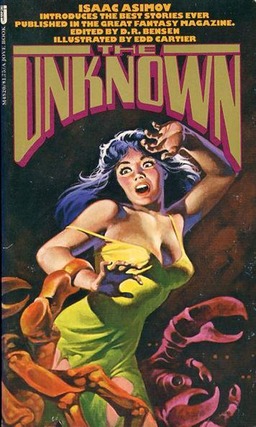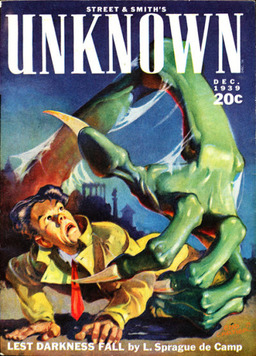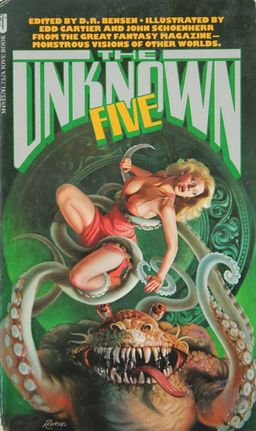Vintage Treasures: The Unknown, edited by D.R. Bensen
 In all of our recent discussions of pulps, we have sorely neglected one of the greatest pulp fantasy magazines of all time: John W. Campbell’s magnificent Unknown. It wasn’t deliberate; we’ve just been focusing on Amazing Stories, Galaxy, and the pulp roots of Dungeons and Dragons of late.
In all of our recent discussions of pulps, we have sorely neglected one of the greatest pulp fantasy magazines of all time: John W. Campbell’s magnificent Unknown. It wasn’t deliberate; we’ve just been focusing on Amazing Stories, Galaxy, and the pulp roots of Dungeons and Dragons of late.
So to do a little catch-up, I thought I’d talk about a splendid anthology I’ve been reading this weekend: The Unknown, a collection of ten short stories and one novelette from the pages of Unknown. If you’ll allow me, I’d like to quote from the Wikipedia entry on Unknown, since I think it does a fine job of summarizing the genesis and impact of Campbell’s great experiment in fantasy:
Unknown (also known as Unknown Worlds) was an American pulp fantasy fiction magazine, published from 1939 to 1943 by Street & Smith, and edited by John W. Campbell. Unknown was a companion to Street & Smith’s science fiction pulp, Astounding Science Fiction, which was also edited by Campbell at the time; many authors and illustrators contributed to both magazines. The leading fantasy magazine in the 1930s was Weird Tales, which focused on shock and horror. Campbell wanted to publish a fantasy magazine with more finesse and humor than Weird Tales, and put his plans into action when Eric Frank Russell sent him the manuscript of his novel Sinister Barrier, about aliens who own the human race… The magazine is generally regarded as the finest fantasy fiction magazine ever published, despite the fact that it was not commercially successful, and in the opinion of science fiction historian Mike Ashley it was responsible for the creation of the modern fantasy publishing genre.
The Unknown contains an excellent survey of Unknown magazine, with entertaining editorial comments and fiction contributions from Henry Kuttner, Nelson S. Bond, Theodore Sturgeon, L. Sprague de Camp, H. L. Gold, Manly Wade Wellman, Fredric Brown, and Anthony Boucher — plus a Fafhrd and the Gray Mouser tale from Fritz Leiber, and more.
It also reprints interior art from the magazine by the great Edd Cartier (see a sample here), who painted the covers for many Unknown issues. I wish more paperbacks from the era did this, as I found the artwork delightful.

I don’t know a lot about editor D.R. Bensen, to be honest. He wrote one novel I recognized, And Having Writ (cover here), an alternate history in which the crashing spaceship that resulted in the Tunguska event of 1908 managed to maintain control long enough to gently splashdown in the Pacific just outside San Francisco, stranding four aliens who meet a series of prominent figures and world leaders in their quest to return home, including Theodore Roosevelt, J.P. Morgan, Thomas Edison, H. G. Wells, Kaiser Wilhelm, Czar Nicholas II, and many others.
Bensen also wrote westerns, including the Tracker series and several Gunsmoke tie-in novels.
He was perhaps best known as an editor — he edited the works of P. G. Wodehouse and was instrumental in having his works re-issued in paperback in the United States. Bensen edited only two genre anthologies, The Unknown (1963) and its sequel The Unknown 5 (1964).
He’s also known to mystery aficionados for his membership in the Trap Door Spiders, the New York Club that inspired Isaac Asimov’s fictional sleuths The Black Widowers. Bensen was reportedly the model for the character of Roger Halsted.
Not too surprisingly, The Unknown includes a foreword by Isaac Asimov, who considered Unknown his favorite magazine and famously was too intimidated by the high quality of the fiction to dare send in a story for many years. He finally submitted “Author! Author!” in 1943, and, to Asimov’s joy, Campbell accepted it — but the magazine folded before the story appeared. He closes his foreword with a bittersweet note (“Now, in a very indirect and tangential fashion, I am an Unknown author at last.”)
“Author! Author!” eventually made it into print in The Unknown Five, the sequel volume, which appeared in 1964 and collected five longer stories from Unknown by Cleve Cartmill, Jane Rice, Theodore Sturgeon, and James H. Beard, and Alfred Bester.
Bensen’s introduction to The Unknown is entertaining as well. For one thing, he gently refutes Asimov’s claim that he was never an Unknown writer, pointing out that Campbell reprinted many of his letters in the magazines letter column (which, interestingly enough, was also titled And Having Writ — which may give you an idea where Bensen drew inspiration for the title of his novel).
 Bensen describes Asimov’s letters as “quotable,” and in fact he quotes from one of his fan letters in the preface to de Camp’s contribution to the anthology, “The Gnarly Man.”
Bensen describes Asimov’s letters as “quotable,” and in fact he quotes from one of his fan letters in the preface to de Camp’s contribution to the anthology, “The Gnarly Man.”
I’m getting so that I’m practically nuts over anything De Camp writes. He is such easy and entertaining reading that I lose my perspective and go off into torrents of praise at the slightest provocation.
Unknown printed a lot of Sprague de Camp, including the Harold Shea stories (co-authored with Fletcher Pratt), The Wheels of If, Divide and Rule, and Lest Darkness Fall. As Bensen noted (and Mordicai Knode and Tim Callahan at Tor.com recently complained about in the de Camp chapter of their Appendix N survey), de Camp enjoyed putting “ordinary, sometimes crass, people in extraordinary situations.”
Unknown also published famous stories by Robert A. Heinlein, (“Magic, Inc.”, “The Unpleasant Profession of Jonathan Hoag,” and “They”), A.E. van Vogt (“The Book of Ptath”), Frank Belknap Long (“Dark Vision”), and eight full novels by L. Ron Hubbard, including Fear, Typewriter in the Sky, and Slaves of Sleep. It discovered important new writers, including Fritz Leiber — whose first professional fiction sale, the very first Fafhrd and the Gray Mouser tale, “Two Sought Adventure,” appeared in August 1939 — and James H. Schmitz, whose “Greenface” appeared in August 1943.
The Unknown is a terrific sample of some of the best fiction from Unknown. H. L. Gold’s “Trouble with Water,” the humorous tale of a short-tempered man who draws the ire of a water gnome when he snags his hat while fishing and finds himself smitten with a curse that prevents any contact with water, is one of the most famous fantasies ever written, and a brilliant example of the fantastic mixed convincingly with the mundane (a mixture Gold kept close when he became editor of Galaxy magazine a decade later).
It also includes famous tales like Theodore Sturgeon’s “Yesterday Was Monday,” Manly Wade Wellman’s creepy “When It Was Moonlight,” Fredric Brown’s “Armageddon,” and the early Fafhrd and the Gray Mouser tale “The Bleak Shore” by Fritz Leiber.
While I was impressed with the fiction in The Unknown — and there’s a great deal here to enjoy — I must admit that the aspect of the book I most enjoyed was the warm sense of shared nostalgia among the participants (and especially Bensen and Asimov) for the long-vanished Unknown. What they accomplished here is the same thing we strive to do every day at Black Gate: to celebrate the work of those creators who have brought us such wonder and joy. It was a real pleasure to see the same joyous impulse in Bensen, some fifty years ago now, for the magazine he clearly loved.
As he wrote in the last sentence of his introduction, “It’s almost like having Unknown back again. And how I wish we could.”
Here’s the complete table of contents.
Foreword by Isaac Asimov
Introduction by D. R. Bensen
“The Misguided Halo,” Henry Kuttner (1939)
“Prescience,” Nelson S. Bond (1941)
“Yesterday Was Monday,” Theodore Sturgeon (1941)
“The Gnarly Man,” L. Sprague de Camp (1939)
“The Bleak Shore,” Fritz Leiber (1940)
“Trouble with Water,” H. L. Gold (1939)
“Doubled and Redoubled,” Malcolm Jameson (1941)
“When It Was Moonlight,” Manly Wade Wellman (1940)
“Mr. Jinx,” Fredric Brown and Robert Arthur (1941)
“Snulbug” Anthony Boucher (1941)
“Armageddon,” Fredric Brown (1941)
The Unknown was originally published in paperback by Pyramid Books in April 1963, with a colorful and intriguing cover by John Schoenherr (see it here). It was reprinted twice, once in October 1970 with an abstract (and frankly not very interesting) new cover by Brad Johannsen (here), and finally by Jove in August 1978 (cover uncredited), the version pictured here.
UNKNOWN was a creature very much of its time and place. The humor often does not age well. It is like watching Blondie and Dagwood. There is a certain timeless quality with the famous WEIRD TALES fiction that does not age it. There were some attempts to create magazines along the lines of UNKNOWN such as WORLDS BEYOND but none of those lasted more than a few issues. Most of the “novels” were reprinted but surprisingly little of the short fiction from UNKNOWN
Doc,
I don’t argue that. I think that, by trying to make fantasy contemporary and more appealing to his audience, it was inescapable that Campbell would also create literature that would date much more rapidly than the Hyborian age and Atlantean fantasy of Weird Tales.
It’s true even with some of the best stories here. Sharp as they are, they’re still filled with stereotypes — like “Trouble with Water,” in which the businessmen are penny-pinching Jews, and cops are Irish who can’t turn down a free drink.
It’s also clear to me that Campbell accomplished his goal, creating a magazine that would speak to a modern (1940s-era) audience. Given how ambitious Campbell was, that’s nothing to sneeze at.
[…] a lot about pulp fantasy recently — for example, in our recent explorations of Appendix N, Unknown magazine, escaping our genre’s pulp roots, forgotten pulp villains, Clark Ashton […]
[…] 52 vintage paperbacks I bought on eBay for fifteen bucks — a collection which also included The Unknown and Robert Bloch’s Nightmares. (Here’s a pic of the set, since I know I’m gonna […]
[…] reading more about Unknown magazine and the great fiction it published during its brief life, we discussed it in some length in December. Read all of our recent Vintage Treasures article […]
[…] magazine. I covered the 1978 Jove reprints of both books in a lengthy Vintage Treasures post last […]